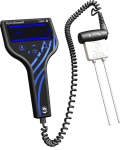This product is not available for new orders.

| Services Available | |
|---|---|
| Repair | Yes |
| Calibration | No |
| Free Support | Yes |
Overview
The CS625 measures the volumetric water content from 0% to saturation. It is similar to our CS616 but is designed specifically for CR200- and CR200X-series dataloggers. This reflectometer has a 0 to 3.3 V square wave frequency output that our CR200(X)-series dataloggers can measure.
Read MoreBenefits and Features
- High accuracy and high precision
- Fast response time
- Designed for long-term unattended water content monitoring
- Probe rods can be inserted from the surface or buried at any orientation to the surface.
Images

Detailed Description
The CS625 consists of two 30-cm-long stainless steel rods connected to a printed circuit board. The circuit board is encapsulated in epoxy, and a shielded four-conductor cable is connected to the circuit board to supply power, enable probe, and monitor the output.
The CS625 measures the volumetric water content of porous media (such as soil) using the time-domain measurement method; a reflectometer (cable tester) such as the TDR100 is not required. This method consists of the CS625 generating an electromagnetic pulse. The elapsed travel time and pulse reflection are then measured and used to calculate soil volumetric water content.
Response Characteristics
The signal propagating along the parallel rods of the CS625 is attenuated by free ions in the soil solution and conductive constituents of the soil mineral fraction. In most applications, the attenuation is not enough to affect the CS625 response to changing water content, and the response is well described by the standard calibration. However, in soil with relatively high soil electrical conductivity levels, compacted soils, or soils with high clay content, the calibration should be adjusted for the specific medium. Guidance for making these adjustments is provided in the operating manual.
Compatibility
Please note: The following shows notable compatibility information. It is not a comprehensive list of all compatible products.
Dataloggers
| Product | Compatible | Note |
|---|---|---|
| CR1000 (retired) | ||
| CR200X (retired) | ||
| CR206X (retired) | ||
| CR211X (retired) | ||
| CR216X (retired) | ||
| CR295X (retired) | ||
| CR300 (retired) | ||
| CR3000 (retired) | ||
| CR310 | ||
| CR5000 (retired) | ||
| CR800 (retired) | ||
| CR850 (retired) | ||
| CR9000X (retired) |
Additional Compatibility Information
RF Considerations
The RF emissions are below FCC and EU limits as specified in EN61326 if the CS625 is enabled less than 0.6 ms, and measurements are made less frequently than once a second. External RF sources can also affect the CS625 operation. Consequently, the CS625 should be located away from significant sources of RF such as ac power lines and motors.
Installation Tool
The CS650G makes inserting soil-water sensors easier in dense or rocky soils. This tool can be hammered into the soil with force that might damage the sensor if the CS650G were not used. It makes pilot holes into which the rods of the sensors can then be inserted. It replaces both the 14383 and 14384.
Data Logger Considerations
Each CS625 requires a single-ended input channel. A control port is used to enable one or more probes.
Note: A maximum of four CS625 probes can be measured by one CR200(X) datalogger. Valid channel options are analog channels 1 through 4.
Specifications
| Operating Temperature Range | 0° to 70°C |
| Probe-to-Probe Variability | ±0.5% VWC in dry soil, ±1.5% VWC in typical saturated soil |
| Precision | 0.1% VWC |
| Resolution | 0.1% VWC |
| Output | 0 to 3.3 V square wave (with frequency dependent on water content) |
| Current Drain | 65 mA @ 12 Vdc (when enabled) |
| Power Supply Voltage | 5 Vdc minimum; 18 Vdc maximum |
| Enable Voltage | 4 Vdc minimum; 18 Vdc maximum |
| Electromagnetic | CE compliant (Meets EN61326 requirements for protection against electrostatic discharge.) |
| Rod Spacing | 32 mm (1.3 in.) |
| Rod Diameter | 3.2 mm (0.13 in.) |
| Rod Length | 300 mm (11.8 in.) |
| Probe Head Dimensions | 85 x 63 x 18 mm (3.3 x 2.5 x 0.7 in.) |
| Cable Weight | 35 g per m (0.38 oz per ft) |
| Weight | 280 g (9.9 oz) without cable |



